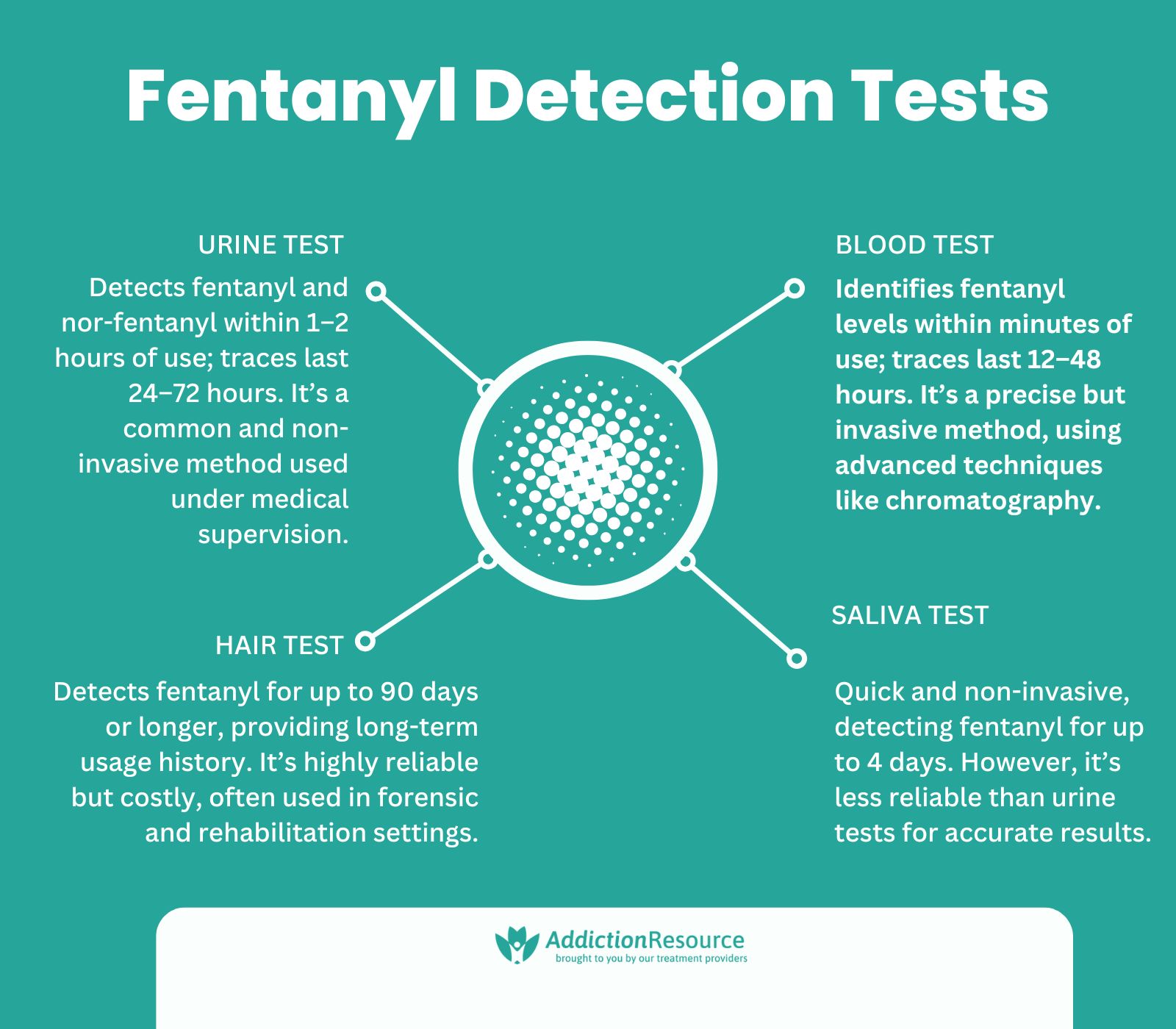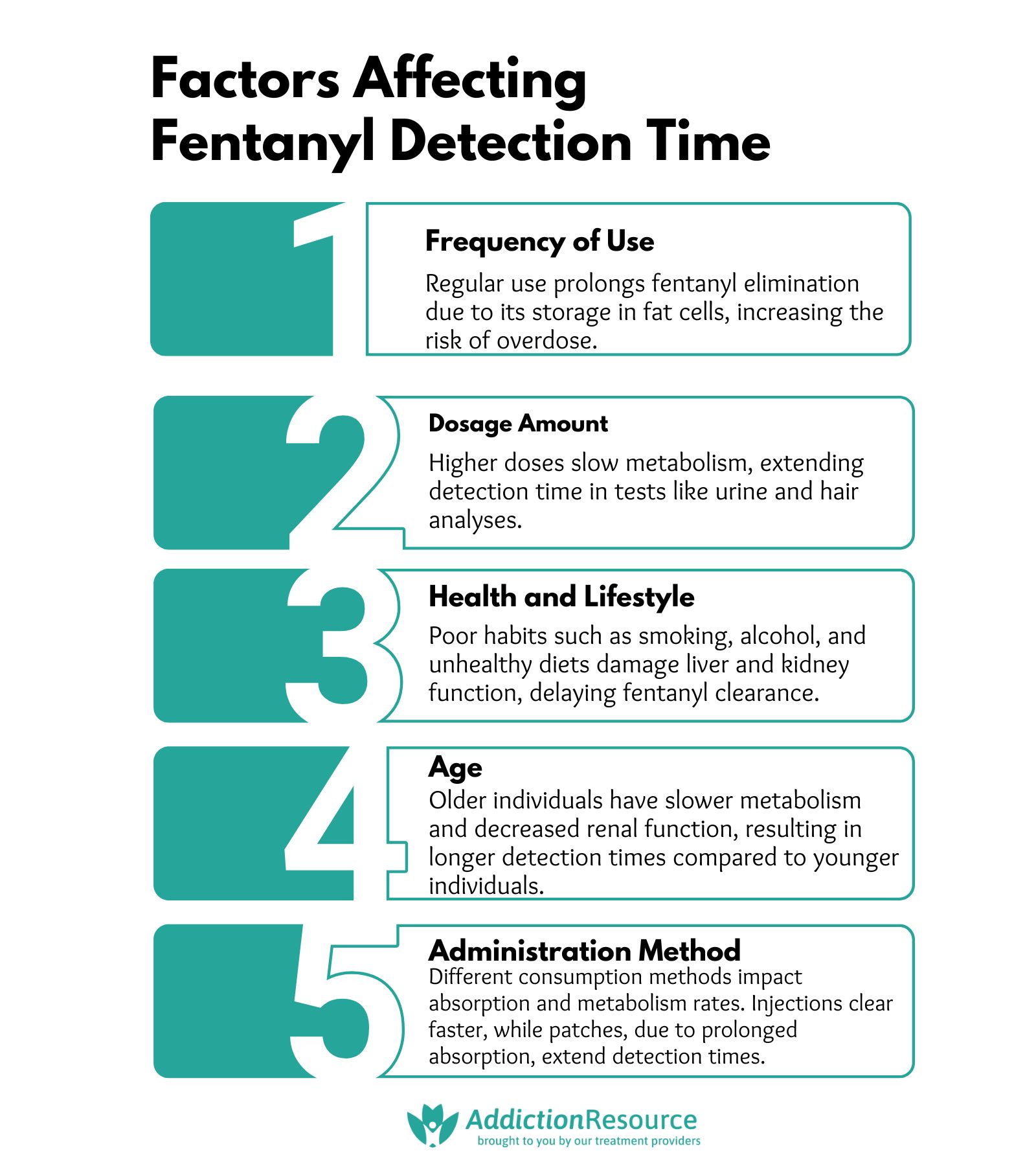How Long Does Fentanyl Stay in the System?

Fentanyl stays in the system for almost 35 hours depending on the frequency of dose, the health of the individual, metabolism, and the duration of use. Fentanyl traces are detected through urine, hair, saliva, and blood tests. Fentanyl is detectable in urine within 1 to 2 hours after the dose and the traces last for up to 24 to 72 hours. In blood tests, fentanyl is detectable easily within a few minutes after use and the remaining traces stay for almost 12 hours. Fentanyl is detected in saliva for 4 days and the traces last up to 3 months and more in hair, according to a study titled “How Long Does Fentanyl Stay in Your System? – 3 Key Factors,” published in 2024 by the Compassion Behavioral Health.
Fentanyl is a synthetic opioid that is 50 to 100 times stronger than morphine. Due to its high potency, it stays in the system for a long time. Fentanyl has a half-life of 3 to 7 hours, so it takes 3 to 4 half-lives to eliminate from the system. Fentanyl lasts for almost 35 hours in the system. Fentanyl takes 0.4-1.5 liters per minute to eliminate from the body, according to a research titled “Clinical pharmacokinetics of fentanyl and its newer derivatives,” published by PubMed. Fentanyl detection time is an important method for monitoring the overdose of fentanyl. This method is used in the recovery process, it helps the doctors to monitor the overdose symptoms and to start the detox medications. Fentanyl detection tests provide clear results of illicit drug use in the workplace or during the employment process.
Table Of Contents:
How the Body Processes Fentanyl?
The body processes fentanyl through absorption, distribution, metabolism, and excretion. Fentanyl is absorbed in the form of nasal sprays, lozenges, transdermal patches, and intravenous injections. Fentanyl activates the mu-opioid receptors (MOR), that convert GTP energy into GDP. The conversion of energy causes the reduction of Cyclic adenosine monophosphate (cAMP) which minimizes the signaling and nerve activities, according to a research titled “Fentanyl,” published by the DrugBank online.
Fentanyl attaches to plasma protein and is distributed in the body. It activates the opioid receptors which enhance the feeling of pleasure and pain relief. Fentanyl is lipophilic which means it dissolves in fats and passes the blood-brain barriers easily. The liver metabolizes fentanyl through the enzyme called CYP3A4, which is important in clearing almost 45-60% of drugs from the body. It converts the fentanyl to nor-fentanyl, which is less strong and easily eliminated from the body. The body excretes fentanyl through urine in 3 to 7 hours because of its half-life.
What tests are done to detect the fentanyl in your system?

The tests that are done to detect the fentanyl in your system are urine tests, blood tests, saliva tests, and hair tests.
The 4 fentanyl detection tests are listed below:
- Urine test: A urine drug monitoring (UDM) tool is used to detect fentanyl and nor-fentanyl in the system. The sample of 30 ml is collected in the container under the doctor’s supervision to avoid test manipulations. Fentanyl is detected within 1 to 2 hours after the use and the traces lasts for up to 24 to 72 hours. Out of all opioid samples, almost 34.6% of urine tests are positive for fentanyl overdose in New York, according to a research titled “The Increasing Prevalence of Fentanyl: A Urinalysis-Based Study Among Individuals With Opioid Use Disorder in New York City” published in 2020 by Wiley Online Library.
- Blood test: Doctors collect the blood sample from the vein with the help of a small needle. Techniques like gas chromatography-mass spectrometry or liquid chromatography-tandem mass spectrometry are used for quick preparation for analysis and help in sample collection, as shown in the research titled “Determination of Fentanyl Analog Exposure Using Dried Blood Spots with LC-MS-MS” published in 2019 by the Oxford Academic. These techniques identify the amount of fentanyl and nor-fentanyl in the body. Blood test shows the results within a few minutes after fentanyl use and the traces last up to 12 to 48 hours.
- Hair test: A hair test is a long-term and effective method to detect fentanyl in the body. Hair test is used in rehabilitation centers, and forensic labs because it is the most reliable test that detects drug traces for 90 days and more. The hair sample is taken about the length of 1.5 inches from the scalp or the body to get accurate results. Hair tests are expensive compared to other tests.
- Saliva test: A saliva test is a quick method to detect fentanyl in the body with the help of an absorbent pad and swab. It takes a few minutes to detect fentanyl and its metabolites in the saliva. Fentanyl traces remain in the saliva for up to 4 days. It is a less painful process and detects the presence of drugs for a short time. Saliva testing is less reliable than urine testing, according to a research titled “An Analysis of the Duration of Fentanyl and Its Metabolites in Urine and Saliva” published by Anesthesia and Analgesia.
What affects the amount of time fentanyl stays in the system?

The factors that affect the amount of time fentanyl stays in the system are the frequency of use, dosage amount, health and lifestyle, age, and administration method.
The 5 factors that affect the amount of time fentanyl stays in the system are listed below:
- Frequency of use: Regular use of fentanyl increases the time of elimination from the system. The detection time increases because of fentanyl’s lipophilic nature which means that the fentanyl is stored for a long time in fat cells of the body. Individuals who use fentanyl regularly are at higher risk of overdose.
- Dosage amount: A high dose of fentanyl increases the detection time during urine and hair tests. Higher doses slow down the metabolism and make it difficult for fentanyl to be eliminated from the body.
- Health and lifestyle: Poor lifestyle like smoking, and poor diet affects the organs. The liver helps in the metabolism of fentanyl into nor-fentanyl. After this conversion almost 10% of the drug is eliminated from the body, according to a research titled “ A review of factors explaining variability in fentanyl pharmacokinetics; focus on implications for cancer patients” published in 2016 by the British Journal of Clinical Pharmacology. Bad habits like alcohol, smoking, and poor diet damage the liver and kidneys. These habits lead to kidney failure because of dehydration and also slow down the liver metabolism which affects the detection time of fentanyl in the system.
- Age: The detection time of fentanyl in older people is high as compared to younger people because of low metabolism, decrease in renal function, and low plasma albumin. The clearance of fentanyl is much lower in older people which increases the test detection time.
- Administration method: The administration method of absorption, distribution, and metabolism impacts the detection time of fentanyl. Fentanyl consumption through injection increases the clearance time in the body. This method is used for pain relief and anesthesia. The patches increase the detection time of fentanyl because of the long absorption time and are prescribed during chronic pain.
Why Fentanyl Detection Times Matter?
Fentanyl detection times matter because they provide accurate results of fentanyl presence in the system which helps in medical care, personal safety, therapies, and medication. Doctors perform urine and blood detection tests before prescribing medications and therapy. Accurate detection results help in quick recovery and decrease the risk of fentanyl overdose and relapse. Fentanyl misuse affects reaction times, coordination, and communication skills which increases the risk of accidents. The detection tests are used in forensics and are mandatory in legal sectors to know the presence of drugs in the systems, as shown in research titled “Detecting Fentanyl Use Through Court-Ordered Mandatory Drug Testing” published in 2024 by the National Institute of Justice. The detection tests are conducted in workplaces to ensure that workers are not misusing fentanyl and other opioids which affects their work environment and performance.
How to Clear Fentanyl from the System Safely?
To clear fentanyl from the system safely requires professional medical supervision to overcome withdrawal symptoms and get proper detoxification treatment without complications. Fentanyl is removed from the body through the liver and kidneys with time and natural metabolic processes. Fentanyl withdrawal causes severe symptoms like anxiety, respiratory issues, depression, and an increase in heart rate that leads to death. Doctors conduct different detection tests to check the severity of fentanyl addiction and then recommend medications and treatments. Doctors keep the individuals hydrated so that kidneys perform function properly and eliminate fentanyl naturally. Any invalid detox procedure like extreme water intake and exercise for fentanyl removal is dangerous for health and leads to dehydration, organ failure, and other psychological effects. Consulting doctors helps individuals overcome fentanyl addiction and reduces the risk of overdose through proper treatment and medications.
What is Fentanyl?
Fentanyl is a synthetic opioid used to treat severe pain in surgeries and cancer. Fentanyl is sourced from the opium poppy plant (Papaver somniferum) and is 50 to 100 times stronger than morphine, as shown in research titled “What is fentanyl?” published in 2021 by the National Institute on Drug Abuse. Fentanyl is prescribed by doctors as a pain reliever after the surgery. The 5 different forms of fentanyl are tablets, patches, nasal sprays, lozenges, and sublingual sprays. Fentanyl is also available illegally in the form of powders and mixed with other drugs like Xanax. Fentanyl activates the opioid receptors in the brain that enhance feelings of pleasure, happiness, and joy and leads to fentanyl overdose.
What are the uses of Fentanyl?
The uses of fentanyl include treating severe pain after surgery and prescribing it to cancer patients with chronic pain. Fenor-fentanylo cancer patients when non-opioid drugs do not minimize the severe pain. Individuals experience intense pain after the surgeries, so it works as an analgesic to minimize the pain. It is used in life-threatening situations to reduce the pain of illness and enhance the quality of life. Doctors recommend fentanyl to individuals with major traumas in OTPs. Fentanyl is 50 to 100 times stronger than morphine, so the chances of misuse are high which leads to dependency.
What are the Side Effects of Fentanyl Addiction?

The side effects of fentanyl addiction are dizziness, nausea, constipation, insomnia, unconsciousness, hallucinations, itching, chest pain, swelling of different body parts, rashes, and confusion. Other long-term effects are reduced libido, breathing problems, and mood swings. Slow breathing leads to death if not considered seriously. The serious side effects are more visible in older people because of malnutrition and other health issues. Fentanyl addiction also causes menstrual and sexual problems.
Can Fentanyl Addiction Lead to Overdose?
Yes, fentanyl addiction leads to overdose when individuals misuse the fentanyl for a long time even knowing its negative consequences. Fentanyl stimulates the opioid receptors and releases a large amount of dopamine in the body that enhances emotions, feelings of happiness, and euphoria which increases the risk of fentanyl addiction. Individuals overdose the fentanyl by taking the medicine more than prescribed. The illicit fentanyl production increases the risk of overdose. Individuals unintentionally consume fentanyl that is present in other drugs like methamphetamine, Xanax, or cocaine which leads to fentanyl overdose.
Does fentanyl stay in the system longer than other opioids?
No, fentanyl does not stay in the system longer than other opioids because of the half-life of 3 to 7 hours it quickly eliminates from the body. Fentanyl detection time depends on factors like frequency, metabolism, testing method, and the amount of dosage. Fentanyl distributes quickly in the body and shows immediate action but is quickly eliminated from the body as well. Fentanyl is a short-acting synthetic opioid which means that the metabolism rate is high as compared to other opioids. The detection time increases if fentanyl doses are high, or used for chronic pain for a long time.
How long does a fentanyl patch stay in the body?
The fentanyl patch stays in the body for almost 48 to 72 hours and is used as a pain killer for chronic pain and cancer pain, according to research titled “Fentanyl Transdermal” published in 2023 by the National Library of Medicine. The fentanyl patches are absorbed through the skin and then distributed in the bloodstream. When the patches are removed from the body, the amount of fentanyl in the system also decreases and within 72 hours the fentanyl is eliminated from the body. The misuse of fentanyl patches also increases its detection time. The traces of fentanyl and nor-fentanyl are detectable in urine and hair tests for a longer time.
What are the dangers of Fentanyl abuse?
The dangers of fentanyl abuse are mental health issues, risk of overdose, emotional stress, withdrawal symptoms, and high dependency. Fentanyl is 50 to 100 times more potent than morphine, so the risk of addiction is high. Fentanyl overdose affects respiratory function which leads to life-threatening health issues. The availability of illegal fentanyl increases which increases the use of fentanyl without knowledge. Fentanyl releases dopamine in the brain that enhances feelings of happiness, joy, and libido which leads to fentanyl dependency. The withdrawal symptoms of fentanyl are cravings, anxiety, muscle tension, and insomnia which force individuals to use fentanyl repeatedly. Fentanyl abuse affects the heart and emotional well-being of individuals.
Hope Without Commitment
Find the best treatment options. Call our free and confidential helpline
Most private insurances accepted





